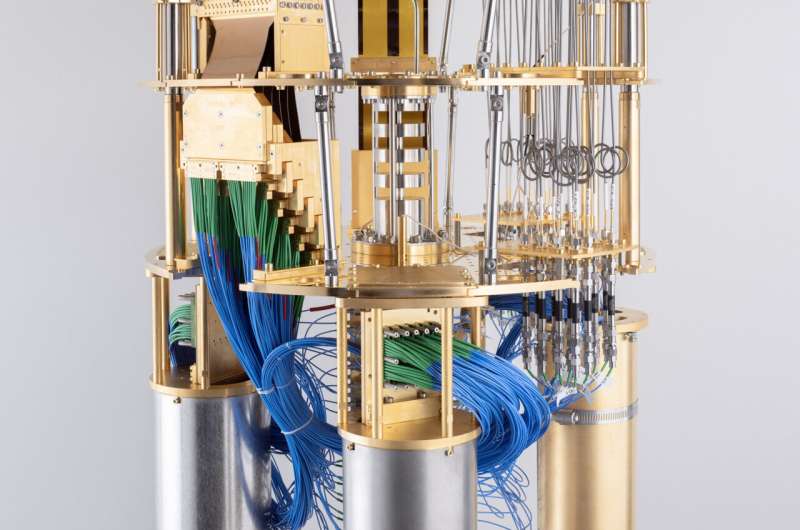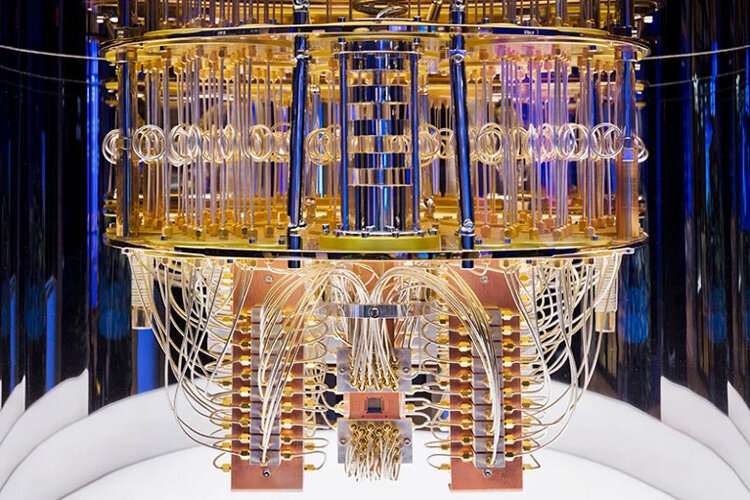This article has been reviewed according to Science X's editorial process and policies. Editors have highlighted the following attributes while ensuring the content's credibility:
fact-checked
peer-reviewed publication
trusted source
proofread
New technique in error-prone quantum computing makes classical computers sweat

Despite steady improvements in quantum computers, they're still noisy and error-prone, which leads to questionable or wrong answers. Scientists predict that they won't truly outcompete today's "classical" supercomputers for at least five or ten years, until researchers can adequately correct the errors that bedevil entangled quantum bits, or qubits.
But a new study shows that even lacking good error correction, there are ways to mitigate errors that could make quantum computers useful today.
Researchers at IBM Quantum in New York and their collaborators at the University of California, Berkeley, and Lawrence Berkeley National Laboratory report today (June 14) in the journal Nature that they pitted a 127-qubit quantum computer against a state-of-the-art supercomputer, and for at least one type of calculation, bested the supercomputer.
The calculation wasn't chosen because it was difficult for classical computers, the researchers say, but because it's similar to ones that physicists make all the time. Crucially, the calculation could be made increasingly complex in order to test whether today's noisy, error-prone quantum computers can produce accurate results for certain types of common calculations.
The fact that the quantum computer produced the verifiably correct solution as the calculation became more complex, while the supercomputer algorithm produced an incorrect answer, provides hope that quantum computing algorithms with error mitigation, instead of the more difficult error correction, could tackle cutting-edge physics problems, such as understanding the quantum properties of superconductors and novel electronic materials.
"We're entering the regime where the quantum computer might be able to do things that current algorithms on classical computers cannot do," said UC Berkeley graduate student and study co-author Sajant Anand.
"We can start to think of quantum computers as a tool for studying problems that we wouldn't be able to study otherwise," added Sarah Sheldon, senior manager for Quantum Theory and Capabilities at IBM Quantum.
Conversely, the quantum computer's trouncing of the classical computer could also spark new ideas to improve the quantum algorithms now used on classical computers, according to co-author Michael Zaletel, UC Berkeley associate professor of physics and holder of the Thomas and Alison Schneider Chair in Physics.
"Going into it, I was pretty sure that the classical method would do better than the quantum one," he said. "So, I had mixed emotions when IBM's zero-noise extrapolated version did better than the classical method. But thinking about how the quantum system is working might actually help us figure out the right classical way to approach the problem. While the quantum computer did something that the standard classical algorithm couldn't, we think it's an inspiration for making the classical algorithm better so that the classical computer performs just as well as the quantum computer in the future."
Boost the noise to suppress the noise
One key to the seeming advantage of IBM's quantum computer is quantum error mitigation, a novel technique for dealing with the noise that accompanies a quantum computation. Paradoxically, IBM researchers controllably increased the noise in their quantum circuit to get even noisier, less accurate answers and then extrapolated backward to estimate the answer the computer would have gotten if there had been no noise. This relies on having a good understanding of the noise that affects quantum circuits and predicting how it affects the output.
The problem of noise comes about because IBM's qubits are sensitive superconducting circuits that represent the zeroes and ones of a binary computation. When the qubits are entangled for a calculation, unavoidable annoyances such as heat and vibration can alter the entanglement, introducing errors. The greater the entanglement, the worse the effects of noise.
In addition, computations that act on one set of qubits can introduce random errors in other, uninvolved qubits. Additional computations then compound these errors. Scientists hope to use extra qubits to monitor such errors so they can be corrected—so-called fault-tolerant error correction. But achieving scalable fault-tolerance is a huge engineering challenge, and whether it will work in practice for ever greater numbers of qubits remains to be shown, Zaletel said.
Instead, IBM engineers came up with a strategy of error mitigation they called zero noise extrapolation (ZNE), which uses probabilistic methods to controllably increase the noise on the quantum device. Based on a recommendation from a former intern, IBM researchers approached Anand, postdoctoral researcher Yantao Wu and Zaletel to ask their help in assessing the accuracy of the results obtained using this error mitigation strategy. Zaletel develops supercomputer algorithms to solve difficult calculations involving quantum systems, such as the electronic interactions in new materials. These algorithms, which employ tensor network simulations, can be directly applied to simulate interacting qubits in a quantum computer.
Over a period of several weeks, Youngseok Kim and Andrew Eddins at IBM Quantum ran increasingly complex quantum calculations on the advanced IBM Quantum Eagle processor, and then Anand attempted the same calculations using state-of-the-art classical methods on the Cori supercomputer and Lawrencium cluster at Berkeley Lab and the Anvil supercomputer at Purdue University. When Quantum Eagle was rolled out in 2021, it had the highest number of high-quality qubits of any quantum computer, seemingly beyond the ability of classical computers to simulate.
In fact, exactly simulating all 127 entangled qubits on a classical computer would require an astronomical amount of memory. The quantum state would need to be represented by 2 to the power of 127 separate numbers. That's 1 followed by 38 zeroes; typical computers can store around 100 billion numbers, 27 orders of magnitude too small. To simplify the problem, Anand, Wu and Zaletel used approximation techniques that allowed them to solve the problem on a classical computer in a reasonable amount of time, and at a reasonable cost. These methods are somewhat like jpeg image compression, in that they get rid of less important information and keep only what's required to achieve accurate answers within the limits of the memory available.
Anand confirmed the accuracy of the quantum computer's results for the less complex calculations, but as the depth of the calculations grew, the results of the quantum computer diverged from those of the classical computer. For certain specific parameters, Anand was able to simplify the problem and calculate exact solutions that verified the quantum calculations over the classical computer calculations. At the largest depths considered, exact solutions were not available, yet the quantum and classical results disagreed.
The researchers caution that while they can't prove that the quantum computer's final answers for the hardest calculations were correct, Eagle's successes on the previous runs gave them confidence that they were.
"The success of the quantum computer wasn't like a fine-tuned accident. It actually worked for a whole family of circuits it was being applied to," Zaletel said.

Friendly competition
While Zaletel is cautious about predicting whether this error mitigation technique will work for more qubits or calculations of greater depth, the results were nonetheless inspiring, he said.
"It sort of spurred a feeling of friendly competition," he said. "I have a sense that we should be able to simulate on a classical computer what they're doing. But we need to think about it in a clever and better way—the quantum device is in a regime where it suggests we need a different approach."
One approach is to simulate the ZNE technique developed by IBM.
"Now, we're asking if we can take the same error mitigation concept and apply it to classical tensor network simulations to see if we can get better classical results," Anand said. "This work gives us the ability to maybe use a quantum computer as a verification tool for the classical computer, which is flipping the script on what's usually done."
More information: Youngseok Kim et al, Evidence for the utility of quantum computing before fault tolerance, Nature (2023). DOI: 10.1038/s41586-023-06096-3
Göran Wendin et al, Quantum computer scales up by mitigating errors, Nature (2023). DOI: 10.1038/d41586-023-01884-3 , www.nature.com/articles/d41586-023-01884-3
Journal information: Nature
Provided by University of California - Berkeley





















